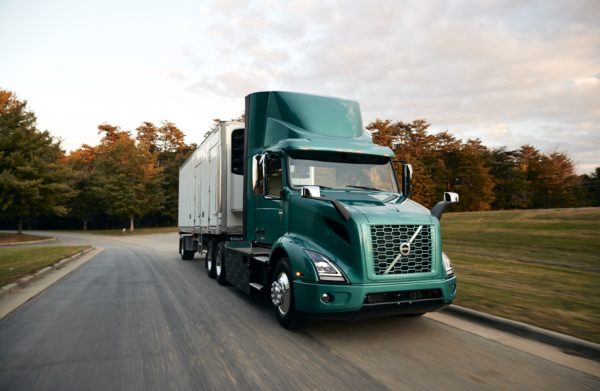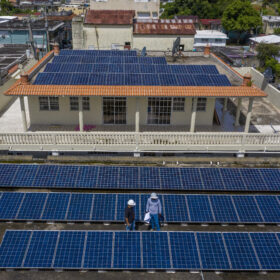WattEV was awarded a $5 million grant to support the buildout of a 12 electric truck, 4 MW charging station in Bakersfield, California, backed by an onsite solar plus storage facility. The grant is from the California Energy Commission, and will represent one of the state’s first solar-powered truck charging stops dedicated to heavy-duty electric trucks.
The facility will be supported by 5 MW of solar power plus second-life energy storage. As the site scales to as many as 40 charging stations, it will be upgraded to 25 MW of solar plus storage at the 110 acre site, with 40 MW of charging capacity.

Image: WattEV
The site will have light-duty, medium and heavy chargers with rates of 250 kW, 350 kW, and 1 MW capacities. The 1 MW chargers will deliver 320 miles of range to a Class 8, 80,000 pound truck in 30 minutes.
No hardware or design specifics were available on the solar or energy storage project.
Joining WattEV on the project are the San Joaquin Valley Air Pollution Control District, the Central California Asthma Collaborative, Greenlots, and Power Electronics, among others.
In addition to the Bakersfield project, WattEV said it is in the planning stages for similar projects in San Bernardino and Gardena in Southern California. Both of those truck stops would serve the Port of Los Angeles and Port of Long Beach and the warehouses fed by goods coming through the ports.
 To date, WattEV raised $6 million in private equity seed funding led by Canon Equity to enable these projects and support further expansion.
To date, WattEV raised $6 million in private equity seed funding led by Canon Equity to enable these projects and support further expansion.
WattEV said it expects to break ground at the Bakersfield facility in October. The initial buildout will cost in excess of $10 million, an is expected to take two years to construct. Reaching the company’s goal of 40 charging stations is estimated to cost more than $30 million.
The company said it hopes to have 12,000 trucks under management by 2030, with 1 GW of charging capacity. Recently, it signed a deal with Volvo for six VNR Electric Class 8 trucks. The VNR has a 264-kWh lithium-ion battery, which charges up to 80% within 70 minutes. It has an operating range of up to 150 miles.

The company also secured purchase incentive vouchers from the California Air Resources Board’s Hybrid and Zero-Emission Truck and Bus Voucher Incentive Project. WattEV also applied for an additional 24 vouchers, in an effort to reach 30 units before the end of 2022. It also placed a reservation for 50 Tesla semis.
WattEV also signed its first electric truck transportation contract with TTSI for 16 trucks to haul loads from ports to regional destinations. TTSI will use WattEV’s trucks, charging infrastructure, and EV management services.
One question is how the solar-plus-storage microgrid facility will be used. It’s probably safe to assume that the facility will be used to mitigate energy costs, while prioritizing demand charge management.
The quantity and source for the second-life batteries is not yet known. Eventually, batteries may come from used electric trucks, creating a circular economy for batteries.
When combined with software being developed by WattEV to meet transportation company sustainability requirements, a growing percentage of emission-free electricity (particularly solar) could directly power the trucks.
When considering the large volumes of the California power grid which need to be upgraded in order to carry higher loads, and that those costs are typically shouldered by solar developers, it may well be that the solar-plus-storage facility was chosen to minimize transmission upgrade costs.
This content is protected by copyright and may not be reused. If you want to cooperate with us and would like to reuse some of our content, please contact: editors@pv-magazine.com.








By submitting this form you agree to pv magazine using your data for the purposes of publishing your comment.
Your personal data will only be disclosed or otherwise transmitted to third parties for the purposes of spam filtering or if this is necessary for technical maintenance of the website. Any other transfer to third parties will not take place unless this is justified on the basis of applicable data protection regulations or if pv magazine is legally obliged to do so.
You may revoke this consent at any time with effect for the future, in which case your personal data will be deleted immediately. Otherwise, your data will be deleted if pv magazine has processed your request or the purpose of data storage is fulfilled.
Further information on data privacy can be found in our Data Protection Policy.